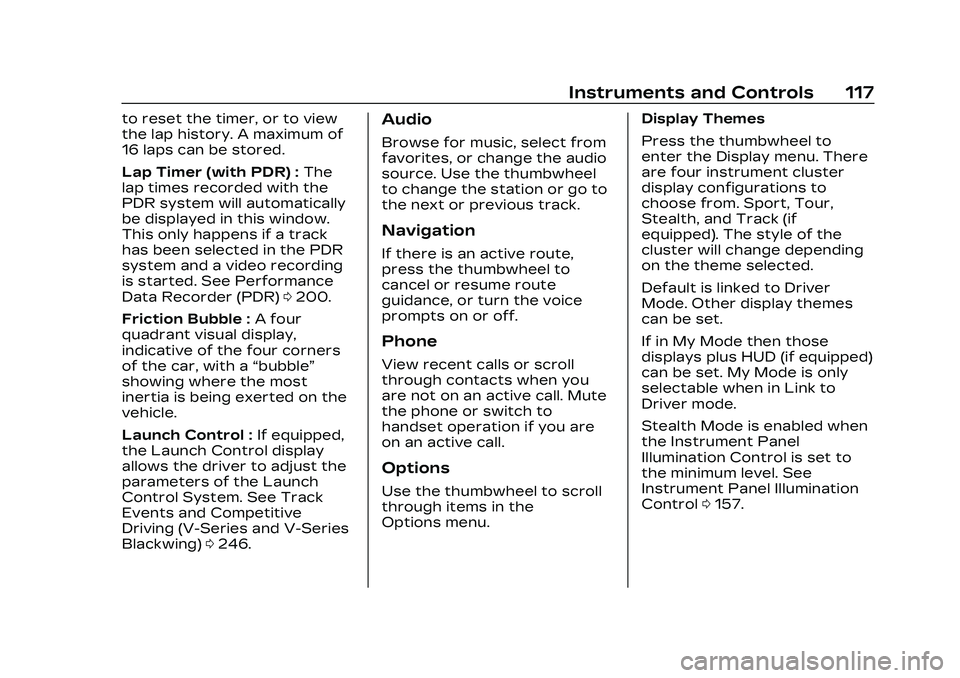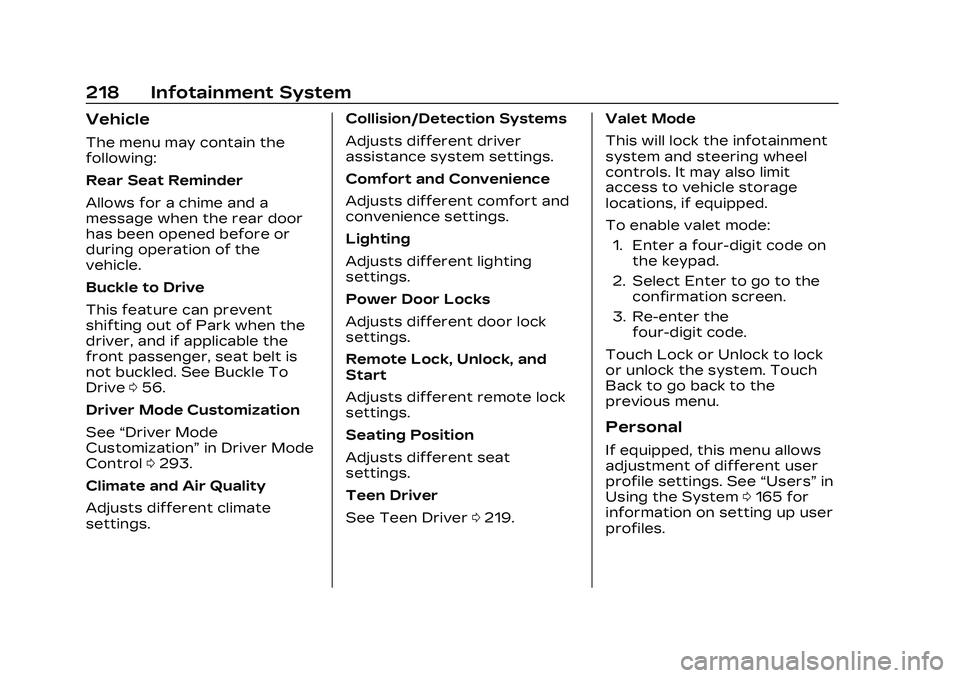four wheel drive CADILLAC CT5 2023 Owners Manual
[x] Cancel search | Manufacturer: CADILLAC, Model Year: 2023, Model line: CT5, Model: CADILLAC CT5 2023Pages: 526, PDF Size: 6.85 MB
Page 118 of 526

Cadillac CT5 Owner Manual (GMNA-Localizing-U.S./Canada-16500419) -
2023 - CRC - 5/6/22
Instruments and Controls 117
to reset the timer, or to view
the lap history. A maximum of
16 laps can be stored.
Lap Timer (with PDR) :The
lap times recorded with the
PDR system will automatically
be displayed in this window.
This only happens if a track
has been selected in the PDR
system and a video recording
is started. See Performance
Data Recorder (PDR) 0200.
Friction Bubble : A four
quadrant visual display,
indicative of the four corners
of the car, with a “bubble”
showing where the most
inertia is being exerted on the
vehicle.
Launch Control : If equipped,
the Launch Control display
allows the driver to adjust the
parameters of the Launch
Control System. See Track
Events and Competitive
Driving (V-Series and V-Series
Blackwing) 0246.Audio
Browse for music, select from
favorites, or change the audio
source. Use the thumbwheel
to change the station or go to
the next or previous track.
Navigation
If there is an active route,
press the thumbwheel to
cancel or resume route
guidance, or turn the voice
prompts on or off.
Phone
View recent calls or scroll
through contacts when you
are not on an active call. Mute
the phone or switch to
handset operation if you are
on an active call.
Options
Use the thumbwheel to scroll
through items in the
Options menu. Display Themes
Press the thumbwheel to
enter the Display menu. There
are four instrument cluster
display configurations to
choose from. Sport, Tour,
Stealth, and Track (if
equipped). The style of the
cluster will change depending
on the theme selected.
Default is linked to Driver
Mode. Other display themes
can be set.
If in My Mode then those
displays plus HUD (if equipped)
can be set. My Mode is only
selectable when in Link to
Driver mode.
Stealth Mode is enabled when
the Instrument Panel
Illumination Control is set to
the minimum level. See
Instrument Panel Illumination
Control
0157.
Page 219 of 526

Cadillac CT5 Owner Manual (GMNA-Localizing-U.S./Canada-16500419) -
2023 - CRC - 5/6/22
218 Infotainment System
Vehicle
The menu may contain the
following:
Rear Seat Reminder
Allows for a chime and a
message when the rear door
has been opened before or
during operation of the
vehicle.
Buckle to Drive
This feature can prevent
shifting out of Park when the
driver, and if applicable the
front passenger, seat belt is
not buckled. See Buckle To
Drive056.
Driver Mode Customization
See “Driver Mode
Customization” in Driver Mode
Control 0293.
Climate and Air Quality
Adjusts different climate
settings. Collision/Detection Systems
Adjusts different driver
assistance system settings.
Comfort and Convenience
Adjusts different comfort and
convenience settings.
Lighting
Adjusts different lighting
settings.
Power Door Locks
Adjusts different door lock
settings.
Remote Lock, Unlock, and
Start
Adjusts different remote lock
settings.
Seating Position
Adjusts different seat
settings.
Teen Driver
See Teen Driver
0219. Valet Mode
This will lock the infotainment
system and steering wheel
controls. It may also limit
access to vehicle storage
locations, if equipped.
To enable valet mode:
1. Enter a four-digit code on the keypad.
2. Select Enter to go to the confirmation screen.
3. Re-enter the four-digit code.
Touch Lock or Unlock to lock
or unlock the system. Touch
Back to go back to the
previous menu.
Personal
If equipped, this menu allows
adjustment of different user
profile settings. See “Users”in
Using the System 0165 for
information on setting up user
profiles.
Page 254 of 526

Cadillac CT5 Owner Manual (GMNA-Localizing-U.S./Canada-16500419) -
2023 - CRC - 5/10/22
Driving and Operating 253
2. Using the G-Force Gaugein the HUD display, use
enough pedal force to
completely stop the vehicle
in four to five seconds.
(~0.7g Decel level to stop
the vehicle in a straight
line). If ABS activates,
braking is too hard.
3. Repeat the first two steps 20 consecutive times, this
should take about
five minutes.
4. After completing the 20 stops, cool the brakes by
driving for 8 km (5 mi) at
100 km/h (60 mph).
Alternative Closed Course
Brake Burnishing Procedure
This brake burnish procedure
should only be run on vehicles
with a factory equipped brake
system.
This procedure should only be
run on a track and only on dry
pavement. Brake pedal fade
will occur during this track
burnish procedure and can cause brake pedal travel and
force to increase. This could
extend stopping distance until
the brakes are fully burnished.
1. Start track lapping at lower speeds and lower
braking efforts for
three minutes of driving.
Allow for increased braking
distances due to reduced
brake output.
2. After Step 1, increase speed and braking effort
for the next six minutes of
lapping, gradually ending
up at 90% effort. Continue
to allow for increased
braking distance due to
reduced brake output.
3. Cool the brakes by lapping with minimal light braking
for six minutes.
Wheel Alignment
Wheel alignment suggested
specs for track use:
Road Course (V-Series)
.Front: -2.0 deg camber,
0.2 deg total toe
.Rear: -1.7 deg camber,
0.2 deg total toe
Road Course (V-Series
Blackwing)
.Front: -2.5 deg camber,
0.1 deg total toe
.Rear: -1.5 deg camber,
0.1 deg total toe
Tire Inflation Pressure
Guidelines
Tire inflation pressures affect
vehicle handling and tire life,
and should be adjusted for
various types of tracks/
courses.
Inspect the tires prior to every
track/course session. Track/
course driving will reduce the
tire tread life.
To maximize tire life, drive
800 km (500 mi) prior to
racetrack driving or complete
the minimum track running
that will increase the tire
pressures by 35 kPa (5 psi).
After this, immediately let the
tires cool to cold pressures.
Page 288 of 526

Cadillac CT5 Owner Manual (GMNA-Localizing-U.S./Canada-16500419) -
2023 - CRC - 5/10/22
Driving and Operating 287
.Be disabled when the
coolant temperature is
below 0 °C (32 °F).
Drive Systems
All-Wheel Drive
Vehicles with this feature
always send engine power to
all four wheels. It is fully
automatic, and adjusts itself as
needed for road conditions.
Brakes
Electric Brake Boost
Vehicles equipped with
electric brake boost have
hydraulic brake circuits that
are electronically controlled
when the brake pedal is
applied during normal
operation. The system
performs routine tests and
turns off within a few minutes
after the vehicle is turned off.
Noise may be heard during
this time. If the brake pedal is
pressed during the tests orwhen the electric brake boost
system is off, a noticeable
change in pedal force and
travel may be felt. This is
normal.
Antilock Brake
System (ABS)
The Antilock Brake System
(ABS) helps prevent a braking
skid and maintain steering
while braking hard.
If there is a problem with ABS,
this warning light stays on.
See Antilock Brake System
(ABS) Warning Light
0128.
ABS does not change the time
needed to get a foot on the
brake pedal and does not
always decrease stopping
distance. If you get too close
to the vehicle ahead, there will not be enough time to apply
the brakes if that vehicle
suddenly slows or stops.
Always leave enough room
ahead to stop, even with ABS.
Using ABS
Do not pump the brakes. Just
hold the brake pedal down
firmly. Hearing and feeling ABS
operate is normal.
Braking in Emergencies
ABS allows steering and
braking at the same time. In
many emergencies, steering
can help even more than
braking.
Page 421 of 526

Cadillac CT5 Owner Manual (GMNA-Localizing-U.S./Canada-16500419) -
2023 - CRC - 5/6/22
420 Vehicle Care
If using winter tires:
.Use tires of the same brand
and tread type on all four
wheel positions.
.Use only radial ply tires of
the same size, load range,
and speed rating as the
original equipment tires.
Winter tires with the same
speed rating as the original
equipment tires may not be
available for H, V, W, Y, and ZR
speed rated tires. If winter
tires with a lower speed rating
are chosen, never exceed the
tire's maximum speed
capability.
Run-Flat Tires
This vehicle, when new, may
have had run-flat tires. There
is no spare tire, no tire
changing equipment, and no
place to store a tire in the
vehicle.
{Warning
While driving with run-flat
tires at a reduced inflation
pressure, avoid making
sudden stops or severe
maneuvers as the handling
capabilities of the tires will
be reduced. Driving too fast
could cause loss of control
and you or others could be
injured. Do not drive over
80 km/h (50 mph) with the
tire operating at low
pressure. Drive cautiously
and check the tire pressure
as soon as possible.
Run-flat tires can be driven up
to 80 km (50 mi) at speeds
less than 80 km/h (50 mph)
after a loss of inflation
pressure has occurred. There
is no need to stop on the side
of the road to change the tire.
The possible driving range
after a pressure loss will vary
based on the vehicle load and
driving conditions. As soon as possible, contact the nearest
authorized GM or run-flat
servicing facility for inspection
and repair or replacement.
When driving on a deflated
run-flat tire, avoid potholes
and other road hazards that
could damage the tire and/or
wheel beyond repair. When a
tire has been damaged, or if
driven any distance while
deflated, check with an
authorized run-flat tire service
center to determine whether
the tire can be repaired or
should be replaced. To
maintain the run-flat feature,
all replacement tires must be
run-flat tires.
To locate the nearest GM or
run-flat servicing facility, call
Customer Assistance.
Self-Sealing Tires
This vehicle may have
self-sealing tires. These tires
have a material inside that can
seal punctures from common
road hazards, such as nails
Page 474 of 526

Cadillac CT5 Owner Manual (GMNA-Localizing-U.S./Canada-16500419) -
2023 - CRC - 5/6/22
Service and Maintenance 473
.Drain and fill engine cooling
system. Or every six years,
whichever comes first. See
Cooling System0392.
Severe Conditions
Requiring More Frequent
Maintenance*
.Public service, military,
or commercial use vehicles
to include the following:
‐ Ambulances, police cars,
and emergency rescue
vehicles.
‐ Civilian vehicles such as
light duty pick-up trucks,
SUVs, and passenger cars
that are used in military
applications.
‐ Recovery vehicles such as
tow trucks and flatbed
single vehicle carriers or
any vehicle that is
consistently used in towing
trailers or other loads.
‐ High use commercial
vehicles such as courier
delivery vehicles, private
security patrol vehicles, or any vehicles that
operate on a 24–hour
basis.
‐ Any vehicle consistently
operated in a high sand or
dust environment such as
those used on oil pipelines
and similar applications..Vehicles that are regularly
used for short trips of 6 km
(4 mi) or less.
The oil life indicator will show
you when to change the oil
and filter. Under severe
conditions the indicator may
come on before 12 000 km
(7,500 mi).
* Footnote: Under extreme
driving conditions listed
above, it may be necessary
to replace your spark plugs
at more frequent intervals.
For further assistance in
determining the most
suitable service maintenance
intervals for your vehicle,
please contact your
authorized GM Dealer. Extreme service is for
vehicles mainly driven
off-road in four-wheel drive
or used in farming, mining,
forestry, or snow plowing.
Additional Required
Services
—Severe Service
Every 72 000 km (45,000 mi)
.Change automatic
transmission fluid and filter.
.Change manual transmission
fluid. (If equipped)
.Change transfer case fluid,
if equipped with AWD. Do
not directly power wash the
transfer case and/or front/
rear axle output seals. High
pressure water can
overcome the seals and
contaminate the transfer
case fluid. Contaminated
fluid will decrease the life of
the transfer case and/or
axles and should be
replaced.